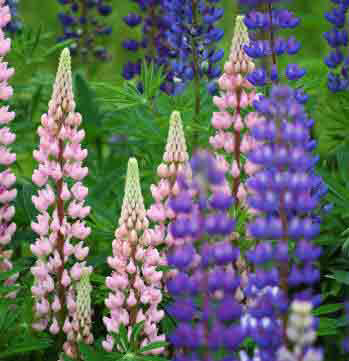
Lupins are one of the easiest and showiest perennials you can grow – providing you can deter the slugs on the spring. (More about those later.) Lupinus – to give them their botanical name - are deservedly popular and one of the great perennials for old English style gardens; Cottage gardens. They are members of the wide-ranging pea family – Leguminosae – and as such help to enrich the soil with the important food element, Nitrogen.
Lupins are herbaceous perennials, which will die down each winter, but soon grow into clumps again after the winter. They can also be grown as an annual sowing early in the year to flower mid-summer. Not many will discard them once they have seen the dazzling display of tall flower spikes.
Various Lupins are cultivated for agricultural uses, and increasingly are being used for food crops mainly in the Mediterranean areas, where they were once used in many dishes. They are a good alternative to the soy bean.

As they are members of the higher family of Leguminosae, they ar beneficial to all soils enriching them with Nitrogen from their root system. As such they were at one time used extensively as a green manure being plowed into the ground to release they nitrogenous substances.
Lupins as they are known in North America have been subject to expert hybridization, resulting in brighter flowers, disease resistance, sturdiness and in particular, the ease of getting them into flower in the same season as sowing seed.
They are one of the most resilient of towering tall flowers in the perennial bed, and have the decided advantage of rarely needing staking, though a loose string around the perimeter of the clump helps.
As well as having tall flower spikes of assorted colours, Lupins have attractive foliage, with palmate leaves sometimes glossy green, but also silvery grey on some of the species.
Lupins prefer a light well-drained soil which is either neutral or slightly acid ph. But they are very adaptable, and all but the heaviest of clay soils are home to showy groups of this tall flower group of plants.
Lupins prefer a full sun position, but will also thrive in partial or dappled shade. I have also seen and photographed some worthwhile groups in areas of heavy shade but good light.
Containers of adequate size or suitable for Lupines on the patio, where they will give a god show for maybe a season or two. However, they will not be happy confined in a container for more than the second year.
Lupins can be bought as young small potted plants in the spring normally selling out quick! Otherwise they can be sown as seed early in the year or late autumn and overwintered before planting out in spring.
Watering is rarely require when grown in open beds or other garden situations, and they will soon let you know if water is required as the foliage cluster droops quite sadly. They soon to recover after a good soaking.
Division is not always required or desirable though older clumps can be carefully divided in spring saving the younger outer parts and discarding the inner clump.
Lupins start flowering early summer on tall flower spikes of pea flowers. The display can be enjoyed right through until late summer simply by cutting of the faded seeding stems.
Garden Centers will have varied selection for sale as seed packets. It may be possible to buy single colours in this way, but normally as mixed colours. What a show they will make. Favorites can propagated the following spring by cuttings not seed.
The easiest way to grow new lupines is to sow them from seed. The seed coat is quite hard, and soaking in warm water for a day prior to sowing will help. Otherwise you can carefully abrade the seed coat or nick it with a sharp knife. Soaking is better. Make sure the seeds are covered at least the depth of the seed size.
Young emerging seedlings can infuriate with a seeming reluctance to cast off the old seed pod. Dont be tempted to help. Let them get on with it.
Mid spring is the best time for severing basal side shoots as softwood cuttings and potting separately placing in a cool greenhouse or with attention in a heated propagator.
Slugs are the main problem in early spring just as the growth is sprouting and for a month afterwards.
Lupins sometimes suffer from varied fungal diseases such as root rot and powdery mildew of foliage.